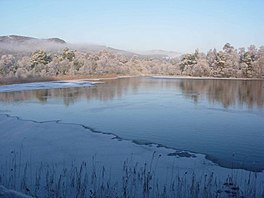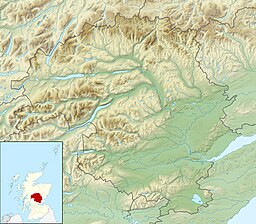Loch of the Lowes is a loch near Dunkeld in Perth and Kinross, Scotland. The loch and the surrounding area are designated as a wildlife reserve, run by the Scottish Wildlife Trust. The loch is also a designated Site of Special Scientific Interest (SSSI), as well as forming part of a Special Area of Conservation.[3][2][1]
| Loch of the Lowes | |
|---|---|
 December 2005 | |
| Location | NO049438 |
| Coordinates | 56°34′38″N 3°32′56″W / 56.5773°N 3.5489°W |
| Type | freshwater loch |
| Primary inflows | Lunan Burn |
| Primary outflows | Lunan Burn |
| Catchment area | 14.9 km2 (3,680 acres)[1] |
| Basin countries | Scotland |
| Surface area | 87.9 ha (217 acres)[2] |
| Average depth | 4.9 m (16 ft)[1] |
| Max. depth | 16 m (53 ft)[1] |
| Water volume | 5,492,700 m3 (193,973,000 cu ft)[1] |
| Shore length1 | 4.4 km (2.7 mi) [2] |
| Surface elevation | 101 m (331 ft)[2] |
| Max. temperature | 15.6 °C (60.0 °F) |
| Min. temperature | 10.0 °C (50.0 °F) |
| Islands | 0 |
| 1 Shore length is not a well-defined measure. | |
The loch hosts a variety of wildlife, including a pair of breeding ospreys, red squirrels, otters and beavers.[4] Wildfowl numbers peak in early winter with migrant greylag geese roosting on the loch. In addition, goldeneyes, mallards, goosanders, wigeons, teals, tufted ducks and great crested grebes can also be seen.
History
editDuring the 19th century, a drainage channel was dug, connecting Loch of Craiglush with Lowes, causing the water levels of the two lochs to equalise. The Lunan Burn now flows through this channel. The reserve land was purchased by the Scottish Wildlife Trust in 1969, due to the loch being the largest mesotrophic loch in the area, and the presence of the rare pondweed Slender Naiad.[5]
Geography
editLoch of the Lowes forms part of a chain of lochs known as the Lunan Lochs.[6] The Lunan Lochs are Lochs Craiglush, Lowes, Butterstone, Clunie and Marlee, and are connected by the Lunan Burn, which drains into the River Isla, itself a tributary of the River Tay. Loch of the Lowes, along with Loch Craiglush and Loch Butterstone is situated just north of the Highland Boundary Fault, and are mesotrophic lochs, and are characterised by a relatively low nutrient level, as their catchment areas are mostly acidic uplands. By comparison, Lochs Clunie and Marlee are situated south of the Highland Boundary Fault, and have a higher nutrient level. The Lunan Lochs are an example of a rare habitat in the United Kingdom, which start from nutrient-poor oligotrophic lochs further upstream; to richer, mesotrophic lochs downstream.[3]
Wildlife
editBirds
editThe loch and surrounding woodland host a large variety of birds. In winter, pink-footed geese, greylag geese, wigeons and whooper swans can be seen on the loch, and in summer, large numbers of swallows, sand martins and swifts can be seen over the water. Tufted ducks, goldeneye and great crested grebe can be seen year-round, and both goldeneye and great crested grebe can be seen performing their courtship dance in early spring.
In the woodlands, there are jays, treecreepers, great spotted woodpeckers, siskins and sparrowhawks.[4] In the winter, redpoll and bramblings frequent the woods, and in summer, redstarts and cuckoos can be found.
Between late March to late August, there are a pair of breeding ospreys. Their nest is situated within 200 metres of an observation hide, allowing up-close viewing through binoculars, telescopes and closed-circuit television (CCTV). They can also be observed via an HD camera from the Visitor Centre or online[7]
Mammals
editFallow and roe deer are often seen from the hide and sometimes otters can be observed. Red squirrels are also quite numerous on the reserve. In 2012 a beaver was spotted on the loch.[8] Beavers were reintroduced to Scotland in 2008, after overhunting led to their disappearance several centuries before and have successfully repopulated much of the area around the Tay and its tributaries.
Fish
editPike, perch and brown trout are all present in the loch.[9] Fishing in or on the loch is not permitted at any time of year.
Access
editThe loch is situated about 2 miles (3 km) north-east of Dunkeld. A small unclassified road off the A923 leads to a small car park on the reserve. All paths and infrastructure are located within a western corner of the loch, however, a short woodland footpath connects the visitor centre to Dunkeld by joining a right of way across this minor road,[10] and is suitable for walkers and mountain bikers, but is not suitable for wheelchair users. There is a cycle rack in the reserve car park,[11] and parking for approximately 24 cars.
Visitor Centre
editThe Scottish Wildlife Trust operates a visitor centre on the western side of the loch. There are three observation hides offering views over the loch, and are situated close to the osprey nest. The visitor centre is one of four visitor centres operated by the Scottish Wildlife Trust, the other three being at Montrose Basin, Falls of Clyde and Jupiter Wildlife Centre. The visitor centre and car park are open on a reduced schedule for a third of the year during winter and an entry fee is required for non-SWT members.
Opening hours:
• 1 March - 31 October: open daily from 10:00-17:00
• 1 November - 28 February: open Friday-Sunday from 10:30-16:00
References
edit- ^ a b c d e John, Murray; Lawrence, Pullar. Bathymetrical Survey of the Fresh-Water Lochs of Scotland, 1897-1909 Lochs of the Tay Basin Volume II - Loch of the Lowes. National Library of Scotland: National Challenger Officer. p. 101. Retrieved 11 January 2019. This article incorporates text from this source, which is in the public domain.
- ^ a b c d "Loch of the Lowes". British Lakes. Retrieved 11 January 2019.
- ^ a b Dunkeld - Blairgowrie Lochs, Joint Nature Conservation Committee
- ^ a b Loch of the Lowes - Reserve Information, Scottish Wildlife Trust
- ^ Tayside Biodiversity Action Plan - Water - Standing Open Water, Tayside Biodiversity, archived from the original on 15 May 2012
- ^ Lunan Lochs Project Natural Care Scheme (PDF), Scottish Natural Heritage, archived from the original (PDF) on 4 March 2016, retrieved 4 May 2013
- ^ Loch of the Lowes Osprey Webcam, Scottish Wildlife Trust
- ^ Osprey Lady departs from Loch of the Lowes and leaves the men to it, The Courier, 2012
- ^ Bathymetrical Survey of the Fresh-Water Lochs of Scotland 1897-1909, National Library of Scotland, 1903
- ^ Dunkeld Path Network, Perthshire Big Tree Country, archived from the original on 9 December 2014
- ^ Reserve Map (PDF), Scottish Wildlife Trust, 2011
